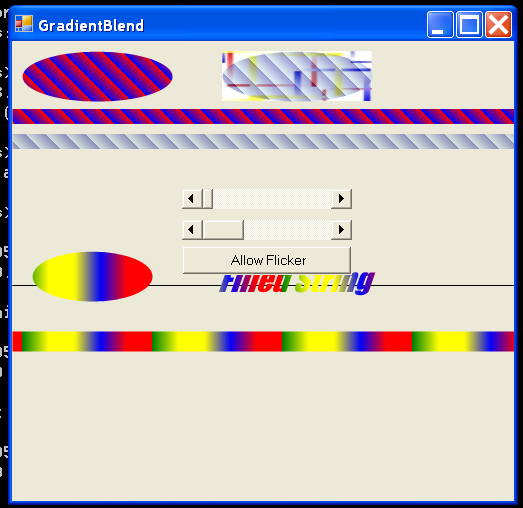Gradient Demo

/*
GDI+ Programming in C# and VB .NET
by Nick Symmonds
Publisher: Apress
ISBN: 159059035X
*/
using System;
using System.Drawing;
using System.Drawing.Imaging;
using System.Drawing.Drawing2D;
using System.Collections;
using System.ComponentModel;
using System.Windows.Forms;
using System.Data;
namespace GradientBlend_c
{
/// <summary>
/// Summary description for GradientBlend.
/// </summary>
public class GradientBlend : System.Windows.Forms.Form
{
private System.Windows.Forms.HScrollBar BlendWidth;
private System.ComponentModel.Container components = null;
private System.Windows.Forms.HScrollBar Skew;
private System.Windows.Forms.Button cmdDoubleBuffer;
private int BlWidth;
private int SkewVal;
private Rectangle EL1Rect;
private Rectangle EL2Rect;
private Region EL1Region;
private Region EL2Region;
private Region EL3Region;
public GradientBlend()
{
//
// Required for Windows Form Designer support
//
InitializeComponent();
//Set up rectangles to draw ellipses in
EL1Rect = new Rectangle(10, 10, 150, 50);
EL2Rect = EL1Rect;
//I could make a new rectangle but I can offset without knowing
//anything about the previous rectangle.
EL2Rect.Offset(200, 0);
//Set up Regions for invalidation
EL1Region = new Region(EL1Rect);
EL2Region = new Region(EL2Rect);
EL3Region = new Region( new Rectangle(new Point(0, 65),
new Size(this.Width, 50)));
//Set up the blend scroll bar
BlendWidth.Top = 120;
BlendWidth.Left = this.Width/3;
BlendWidth.Width = this.Width/3;
BlendWidth.Minimum = 10;
BlendWidth.Maximum = 200;
BlendWidth.SmallChange = 1;
BlendWidth.LargeChange = 10;
BlendWidth.Value = BlendWidth.Minimum;
//Set up the Skew Scroll Bar
Skew.Top = 145;
Skew.Left = this.Width/3;
Skew.Width = this.Width/3;
Skew.Minimum = 10;
Skew.Maximum = 40;
Skew.SmallChange = 1;
Skew.LargeChange = 10;
Skew.Value = Skew.Minimum;
//Set up the double buffer button
cmdDoubleBuffer.Top = Skew.Top + Skew.Height + 5;
cmdDoubleBuffer.Width = Skew.Width;
cmdDoubleBuffer.Left = Skew.Left;
cmdDoubleBuffer.Text = "Allow Flicker";
BlWidth = BlendWidth.Value;
SkewVal = Skew.Value;
// Set up for double buffering.
//This, along with invalidating only those areas that need it TOTALY
//eliminate flicker in this program
this.SetStyle ( ControlStyles.AllPaintingInWmPaint, true);
this.SetStyle ( ControlStyles.DoubleBuffer, true);
this.SetStyle ( ControlStyles.UserPaint, true);
}
/// <summary>
/// Clean up any resources being used.
/// </summary>
protected override void Dispose( bool disposing )
{
if( disposing )
{
if (components != null)
{
components.Dispose();
}
//Dispose of our own objects
EL1Region.Dispose();
EL2Region.Dispose();
EL3Region.Dispose();
}
base.Dispose( disposing );
}
#region Windows Form Designer generated code
/// <summary>
/// Required method for Designer support - do not modify
/// the contents of this method with the code editor.
/// </summary>
private void InitializeComponent()
{
this.BlendWidth = new System.Windows.Forms.HScrollBar();
this.Skew = new System.Windows.Forms.HScrollBar();
this.cmdDoubleBuffer = new System.Windows.Forms.Button();
this.SuspendLayout();
//
// BlendWidth
//
this.BlendWidth.Location = new System.Drawing.Point(32, 224);
this.BlendWidth.Name = "BlendWidth";
this.BlendWidth.Size = new System.Drawing.Size(192, 16);
this.BlendWidth.TabIndex = 0;
this.BlendWidth.Scroll += new System.Windows.Forms.ScrollEventHandler(this.BlendChange);
//
// Skew
//
this.Skew.Location = new System.Drawing.Point(192, 272);
this.Skew.Name = "Skew";
this.Skew.Size = new System.Drawing.Size(104, 16);
this.Skew.TabIndex = 1;
this.Skew.Scroll += new System.Windows.Forms.ScrollEventHandler(this.SkewColor);
//
// cmdDoubleBuffer
//
this.cmdDoubleBuffer.Location = new System.Drawing.Point(40, 304);
this.cmdDoubleBuffer.Name = "cmdDoubleBuffer";
this.cmdDoubleBuffer.Size = new System.Drawing.Size(248, 24);
this.cmdDoubleBuffer.TabIndex = 2;
this.cmdDoubleBuffer.Text = "button1";
this.cmdDoubleBuffer.Click += new System.EventHandler(this.cmdDoubleBuffer_Click);
//
// GradientBlend
//
this.AutoScaleBaseSize = new System.Drawing.Size(5, 13);
this.ClientSize = new System.Drawing.Size(392, 373);
this.Controls.AddRange(new System.Windows.Forms.Control[] {
this.cmdDoubleBuffer,
this.Skew,
this.BlendWidth});
this.Name = "GradientBlend";
this.StartPosition = System.Windows.Forms.FormStartPosition.CenterScreen;
this.Text = "GradientBlend";
this.Load += new System.EventHandler(this.GradientBlend_Load);
this.ResumeLayout(false);
}
#endregion
/// <summary>
/// The main entry point for the application.
/// </summary>
[STAThread]
static void Main()
{
Application.Run(new GradientBlend());
}
private void GradientBlend_Load(object sender, System.EventArgs e)
{
}
protected override void OnPaint ( PaintEventArgs e )
{
e.Graphics.SmoothingMode=SmoothingMode.AntiAlias;
StandardGradient( e.Graphics );
e.Graphics.DrawLine(Pens.Black, 0, cmdDoubleBuffer.Bottom+10, this.Width,
cmdDoubleBuffer.Bottom+10);
InterpolateGradient( e.Graphics );
base.OnPaint(e);
}
private void StandardGradient( Graphics G )
{
//This brush defines how the color is distributed across the whole
//graphics container. Any filled object that gets drawn in the container
//will pick up the color starting with the color gradient at that
//particular point on the screen.
LinearGradientBrush B = new LinearGradientBrush(new PointF(0, 20),
new PointF(BlWidth, SkewVal),
Color.Blue,
Color.Red);
//Draw an image inside the second rectangle
G.DrawImage(Image.FromFile("Colorbars.jpg"), EL2Rect);
//Draw a line across the screen with the brush
//to show the repeating pattern
Pen P = new Pen(B, 15);
G.DrawLine ( P, 0, 75, this.Width, 75 );
//Draw a filled ellipse to show how the colors are used
G.FillEllipse(B, EL1Rect);
//Change the starting and ending colors
//Set the alpha so the image below shows through
Color[] c = {Color.FromArgb(100, Color.LightBlue),
Color.FromArgb(100, Color.DarkBlue)};
B.LinearColors = c;
P.Brush = B;
G.DrawLine ( P, 0, 100, this.Width, 100 );
G.FillEllipse(B, EL2Rect );
//Reclaim some memory
c = null;
P.Dispose();
B.Dispose();
}
private void InterpolateGradient ( Graphics G )
{
//Make a set of colors to use in the blend
Color[] EndColors = {Color.Green,
Color.Yellow,
Color.Yellow,
Color.Blue,
Color.Red,
Color.Red};
//These are the positions of the colors along the Gradient line
float[] ColorPositions = {0.0f, .20f, .40f, .60f, .80f, 1.0f};
//Fill the blend object with the colors and their positions
ColorBlend C_Blend = new ColorBlend();
C_Blend.Colors = EndColors;
C_Blend.Positions = ColorPositions;
//Make the linear brush and assign the custom blend to it
LinearGradientBrush B = new LinearGradientBrush ( new Point(10, 110),
new Point(140, 110),
Color.White,
Color.Black );
B.InterpolationColors = C_Blend;
//Make a graphics path that we can fill and show custom blended fill
GraphicsPath Pth = new GraphicsPath();
Pth.AddEllipse(20, 210, 120, 50);
Pth.AddString("Filled String", new FontFamily("Impact"),
(int)FontStyle.Italic, 30, new Point(200, 220),
StringFormat.GenericDefault );
G.FillPath(B, Pth);
Pen P = new Pen(B, 20);
G.DrawLine ( P, 0, 300, this.Width, 300 );
if (P != null)
P.Dispose();
if (B != null)
B.Dispose();
if (Pth != null)
Pth.Dispose();
}
private void BlendChange(object sender,
System.Windows.Forms.ScrollEventArgs e)
{
BlWidth = BlendWidth.Value;
//Redraw the first ellipse
this.Invalidate(EL1Region);
//Redraw the second ellipse
this.Invalidate(EL2Region);
//Redraw the lines
this.Invalidate(EL3Region);
}
private void SkewColor(object sender,
System.Windows.Forms.ScrollEventArgs e)
{
SkewVal = Skew.Value;
//Redraw the first ellipse
this.Invalidate(EL1Region);
//Redraw the second ellipse
this.Invalidate(EL2Region);
//Redraw the lines
Invalidate(EL3Region);
}
private void cmdDoubleBuffer_Click(object sender, System.EventArgs e)
{
if ( this.GetStyle( ControlStyles.AllPaintingInWmPaint ) &&
this.GetStyle( ControlStyles.DoubleBuffer ) &&
this.GetStyle( ControlStyles.UserPaint ) )
{
cmdDoubleBuffer.Text = "Eliminate Flicker";
this.SetStyle ( ControlStyles.AllPaintingInWmPaint, false);
this.SetStyle ( ControlStyles.DoubleBuffer, false);
}
else
{
cmdDoubleBuffer.Text = "Allow Flicker";
this.SetStyle ( ControlStyles.AllPaintingInWmPaint, true);
this.SetStyle ( ControlStyles.DoubleBuffer, true);
}
}
}
}
 GradientBlend-c.zip( 7 k)
GradientBlend-c.zip( 7 k)Related examples in the same category